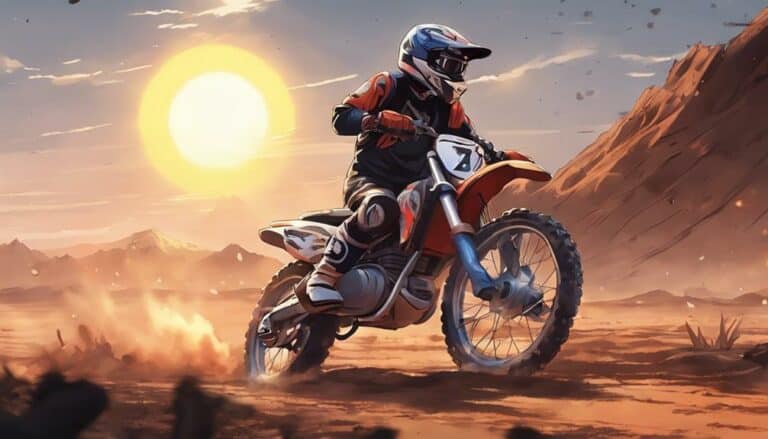When it comes to dirt bikes, did you know that approximately 70% of ignition coil issues arise when the bike is hot? Imagine cruising down the trail, only to face a sudden loss of spark when your engine is at its peak temperature.
The frustration of a stalled bike in the middle of an adventure is not something any rider wants to experience. But fear not, as there are solutions and preventive measures that can help tackle this common problem.
So, let's explore some practical tips and strategies to keep your dirt bike running smoothly even when things heat up.
Key Takeaways
- Inspect for overheating signs to prevent no spark issue when engine is hot
- Test and maintain ignition coil regularly to ensure proper functioning
- Check and address wiring faults to maintain consistent spark output
- Address overheating problems by monitoring temperature and enhancing cooling measures
Common Causes of No Spark Issue
When troubleshooting a dirt bike ignition coil for no spark issues, one common cause stems from the coil overheating under hot engine conditions. The ignition coil may run fine when the engine is cold but fail to generate spark when warm. This issue can be frustrating as the bike may operate perfectly until reaching operating temperature, at which point the spark disappears. Heat-related expansion and changes in electrical resistance within the coil can lead to this loss of spark when the engine is warm.
If you encounter this problem of no spark when the engine is hot, it's essential to inspect the ignition coil for any signs of overheating, such as discoloration or damage to the insulation. Regularly monitoring the coil's performance in varying temperature conditions can help prevent such issues. If your dirt bike experiences no spark when warm, it's advisable to address this promptly to avoid potential engine performance issues. Let's know if you need assistance in troubleshooting or resolving this common problem.
Testing the Ignition Coil
To properly assess the ignition coil's functionality, begin by testing its resistance levels using a multimeter. A healthy ignition coil typically shows a resistance of 0.5 to 5 ohms for the primary winding and 5,000 to 20,000 ohms for the secondary winding.
Testing for insulation breakdown can be done by applying a high-voltage tester to check for leaks or arcing. Additionally, checking the ignition coil's output voltage with a spark tester can verify if it's producing sufficient spark under load conditions.
Regular testing of the ignition coil is important as it can help in early issue detection and prevent situations where the bike fails to spark when hot. By following these steps and ensuring the ignition coil's resistance levels and insulation integrity are within the specified ranges, you can maintain the best performance and reliability of your dirt bike's ignition system.
Checking for Wiring Faults
If you encounter issues with no spark when your dirt bike is hot, take a close look at the wiring connections surrounding the ignition coil for any signs of damage or verification. Validate the wiring harness is free from fraying, burning, or corrosion that could disrupt the electrical flow essential for spark generation.
Confirm all wiring connections are securely fastened to prevent intermittent spark problems while the bike is in operation. Look out for exposed wires or areas where insulation may be compromised, as these can lead to potential short circuits, further hindering spark delivery.
Properly route and secure the wiring to prevent any accidental contact with hot engine parts that could cause damage and affect the spark output. By checking and maintaining the integrity of your wiring connections, you can ensure a consistent electrical flow and reliable spark production in your dirt bike, especially during hot operating conditions.
Addressing Overheating Problems
Properly managing the temperature of your dirt bike's ignition system is crucial to preventing overheating-related issues that can lead to ignition coil failure.
To address overheating problems effectively, consider the following:
- Monitor Temperature: Keep an eye on the operating temperature of your dirt bike's ignition system to prevent overheating issues that may damage the ignition coil.
- Test the Ignition Coil: Perform regular tests on the ignition coil when hot to identify any heat-related problems that could result in a loss of spark.
- Improve Cooling: Enhance the cooling around the ignition system or insulate the ignition coil to mitigate excessive heat buildup and prevent ignition coil failure.
Preventive Maintenance Tips
Maintain excellent performance and prevent potential issues by incorporating these essential Preventive Maintenance Tips for your dirt bike's ignition coil. Regularly inspect and clean the ignition coil to avoid dirt and debris buildup that can impede performance. Guarantee proper grounding of the ignition coil to uphold consistent electrical flow and prevent spark issues. Use dielectric grease on connections to shield against moisture and corrosion, extending the coil's lifespan. Monitor the coil's resistance with a multimeter to catch any fluctuations indicating possible problems before they escalate. Keep the coil and surrounding components well-ventilated to prevent overheating, which can cause spark failures when hot.
| Maintenance Tips | Description |
|---|---|
| Inspect | Regularly check the ignition coil for any dirt and debris buildup. |
| Clean | Keep the ignition coil clean to maintain excellent performance. |
| Grounding | Guarantee proper grounding to uphold consistent electrical flow. |
Conclusion
So, you've tried everything to solve that pesky no spark issue on your dirt bike when it's hot.
You've tested the ignition coil, checked for wiring faults, and even addressed overheating problems. And yet, here you are, still facing the same problem.
Well, isn't that just the spark of irony?
Keep tinkering, keep troubleshooting, and maybe, just maybe, you'll finally get that spark back when it counts.

